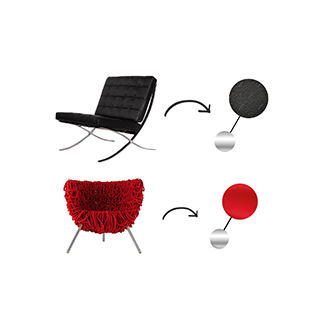Boram, a Ph.D. candidate from Color Lab, has authored a research article titled “A Color-Material Network of Chairs through Materials and Colors,” now published in the Archives of Design Research Journal. Alongside her, Gyunpyo Lee, with a Master’s degree, has contributed as a co-author. The research sheds light on the nuanced choices of Color, Material, and Finishing (CMF) in product design. Through a detailed analysis, it offers insights into the interplay and relationship of CMF by visualizing the network of chair components based on their color and material combinations.
Keywords:
Color Material Finishing (CMF), Network Analysis, Material, Chairs
Abstract
Choice of color, material, and finishing (CMF) has been essential for styling and product design. Empirical studies showed the interaction effects of the three ranges and revealed that particular CMF combinations are relevant than a choice of optimal color, material, and finishing independently. We choose a chair for the target product as a preliminary approach to observe color and material characteristics of the product. We aim to analyze color and material relation using the metrics of social network analysis. We visualized a network of chair components by their colors and materials combination on 1,000 historically meaningful chairs in design history and identified visually dominant components and profiled each in terms of color (14 categories) and material (11 types), called “CM”. With the data set, we facilitated UCINET software to examine the network characteristics such as Size, Density, Centralization, and Subgroup. Also, we composed an interactive network using R to ease navigation and to offer dynamic interfaces. To exploit the experiential and practical values of our network, we conducted a focus group interview (FGI) with seven designers. Results This study offers a visualization of color and material connection over a CM unit network. UCINET showed that CM network’s density was 26.9% and centralization was 6.9%, and one subgroup was formed. FGI feedback showed that the CM network was intuitively informative, brought unexpected surprises, and the possibility of exploring design style. Conclusions This study presents the chair network in a new way of data archiving for color and material information. We expect the visualization of the connectivity among the products through colors and materials to inspire aesthetic inspiration.
Link to the article : http://dx.doi.org/10.15187/adr.2023.02.36.1.7


